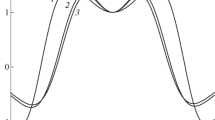Abstract
We consider the asymptotic solution of the Tonks—Langmuir integro-different equation with an Emmert kernel, which describes the behavior of the potential both inside the main plasma volume and in a thin boundary layer. Equations of this type are singularly perturbed due to the small coefficient at the highest order (second) derivative. The asymptotic solution is obtained by the boundary function method. Equations are derived for the first two coefficients in the regular expansion series and in the boundary function expansion. The equation for the first coefficient of the regular series has only a trivial solution. Second-order differential equations are obtained for the first two boundary functions. The equation for the first boundary function is solved numerically on a discrete grid with locally uniform spacing. An approximate analytical expression for the first boundary function is obtained from the linearized equation. This solution adequately describes the behavior of the potential on small distances only.
Similar content being viewed by others
References
L. Tonks and I. Langmuir, “A general theory of the plasma of an arc,” Phys. Rev., 34, No. 6, 876–922 (1929).
E. R. Harrison and W. B. Thompson, “The low pressure plane symmetric discharge,” Proc. Phys. Soc. London, 74, Part 2, No. 476, 145–152 (1959).
E. T. Whittaker and G. N. Watson, A Course of Modern Analysis, 4th Ed., Cambridge Univ. Press (1927).
G. A. Emmert, R. M. Wieland, A. T. Mense, and J. N. Davidson, “Electric sheath and presheath in a collisionless, finite ion temperature plasma,” Phys. Fluids, 23, No. 4, 803–812 (1980).
R. C. Bissel and P. C. Johnson, “The solution of the plasma equations in a plane parallel geometry with a Maxwellian source,” Phys. Fluids, 30, No. 3, 779–786 (1987).
R. C. Bissel, P. C. Johnson, and P. C. Stangeby, “A review of models for collisionless one-dimensional plasma flow to a boundary,” Phys. Fluids B, B1, No. 5, 1133–1140 (1989).
A. B. Vasil’eva and F. V. Butuzov, Asymptotic Expansions of Solutions of Singularly Perturbed Equations [in Russian], Nauka, Moscow (1973).
A. B. Vasil’eva and F. V. Butuzov, Singularly Perturbed Equations in Critical Cases [in Russian], Izd. MGU, Moscow (1978).
A. B. Vasil’eva and F. V. Butuzov, Asymptotic Methods in Singular Perturbation Theory [in Russian], Vysshaya Shkola, Moscow (1990).
D. S. Filippychev, “Simulation of the plasma-sheath equation on condensing grids,” Prikl. Matem. Informatika, No. 14, 35–54 (2003).
Additional information
__________
Translated from Prikladnaya Matematika i Informatika, No. 19, pp. 21–40, 2004.
Rights and permissions
About this article
Cite this article
Filippychev, D.S. Boundary function method to find the asymptotic solution of the plasma—sheath equation. Comput Math Model 17, 14–31 (2006). https://doi.org/10.1007/s10598-006-0009-1
Issue Date:
DOI: https://doi.org/10.1007/s10598-006-0009-1



